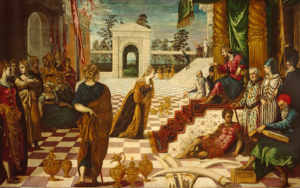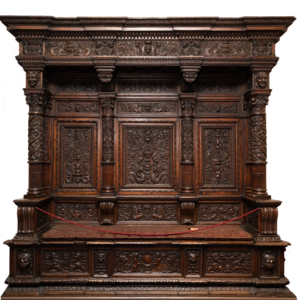In these two portraits, Flemish artist Gaspar de Crayer highlights Augustine, one of western civilization’s most noted philosophers, and Ambrose, the bishop who would bring this great scholar to Christ.
Tag Archives: 16th century
Seat of State
Walnut
Italian, 16th century
A throne is usually a large, ornate chair designed to impress. The majesty and power of the one seated on the throne is visually communicated by the throne’s magnificence. Thrones are also designed to intimidate the one who stands, kneels or bows before the one seated upon it. Today the judge’s bench of a courtroom and the dais of an assemblies’ chairman are designed to have a similar effect.
Technically a high backed, multi-seat bench is a settle. Settles generally have arms, and elaborate ones often have canopies. They are generally stationary and may be an architectural feature built into a room. A settee is the settle’s smaller, movable cousin. Today’s couch, sofa or love seat can be called a settee.
In the 15th and 16th centuries various kinds of settles were used in Italian city-states for ceremonial purposes. In the Chamber of the Great Council of the Doge’s Palace in Venice, massive, built-in settles surround the room. Along the front wall is a raised seven-seat settle for officials of the Maggior Consiglio. The central, larger, higher seat was for the Doge.
The three seat Throne of Giuliano Dei Medici (son of Lorenzo the Magnificent) is very similar to M&G’s Seat of State. Although the provenance of Giuliano’s throne is not clear, most likely it originated in Florence. Another elaborate three-seat throne, attributed to Bartolomeo Baglioni, was probably made in the early 1500s for the Strozzi family of Venice (now currently in the Ringling Museum).
Other than the Seat of State being crafted in Italy in the 16th century, its origin is unknown. But similarity to these and other examples, give credence to it having served as the ceremonial seat of an Italian, high-ranking, three-person governmental body.
M&G’s Seat of State lacks features that would associate it with a particular city or individual. The rich profusion of intricate carvings reflects scrolling foliage, mythical beings, grotesque masks and geometric embellishments. There are small crests, but they appear to be stylized ornaments rather than official symbols. Also, they are not located in prominent places where identifying crests could be recognized and appreciated by those in front of the settle.

The stylized crests are not in the prominent places where one would expect to find official crests (center image). Highly skilled craftsmen embellished M&G’s massive settle with ornate details (left-right images).
The choir stall, also represented in M&G’s furniture collection, is similar to a settle. Choir stalls generally have uniform, narrow seats. Their high backs and canopies are more for acoustics and aesthetics of the room than aggrandizement of the individuals seated on them. Choir stall seats are often collapsible, permitting the choir to stand or kneel during religious services. The visible carvings of a choir stall generally have religious themes with geometric ornamentation.
The Seat of State is constructed of interlocking pieces of solid walnut fitted together with mortise and tenon joints. The seat is a chest, and each person sits on a hinged lid. Because of the height and depth of the seat, unless you have long legs, you must sit forward on the bench, which makes the back too far away to rest comfortably. The settle’s lack of comfort might have helped to keep ceremonies and meetings short.
Standing in front of M&G’s 10’ high, ornately carved, polished red-brown Seat of State one is impressed with its magnificence. Now, envision being led into that position while three officials in their elaborate ceremonial garb sat on those seats and stared down at you. Will they grant your petition? Will they decide in your favor? Whatever they do, you just know they have the power and authority to do it.
It worked. That is exactly what this settle was to settle in your mind.
William Pinkston, retired educator and M&G volunteer
Published in 2020
During the 500th anniversary marking Martin Luther’s nailing of his 95 theses to the door of Wittenberg’s chapel, M&G created an exhibition exploring his life and continuing influence. This video from that exhibition focuses on his musical legacy.
The Della Robbia family is famous—for their secret artistic recipe. Watch to learn more about a pair of sculpture and this family of artists represented in M&G’s collection.
The European furniture in the Museum & Gallery collection has been called the finest in America by Joseph Aronson, author of The Encyclopedia of Furniture. This beautiful Italian cassone is a good example.
The refinement of High Renaissance art motivated mannerist painters like Francesco Cavazzoni to explore other avenues of expression. Legend of the Finding of the True Cross provides an intriguing example.
Giovanni Filippo Criscuolo’s The Last Judgment provides a fascinating study not only for its religious iconography but also for its theological and literary allusions.
The Last Supper was a common subject among 16th-century artists; however, the intriguing iconography in Stefano Cernotto’s rendering displays an inventiveness that is unique.
The historical and iconographic details in this early Spanish painting by Jaun de Flandes make it one of M&G’s most intriguing works.

